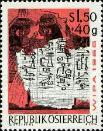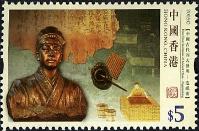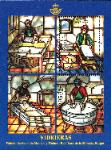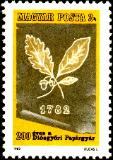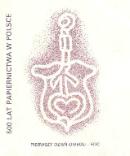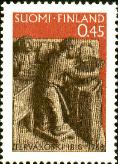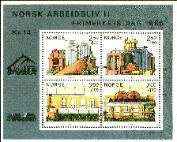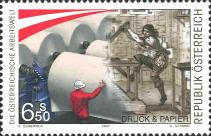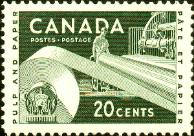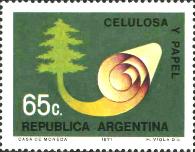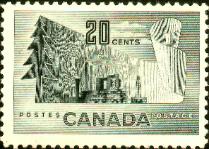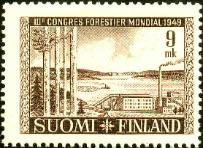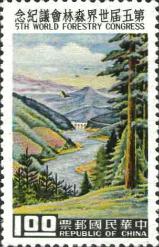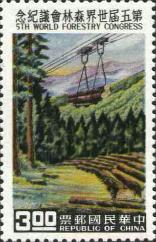A Brief History of Papermaking as Represented on Postage Stamps
The materials used to make books have depended largely upon local resources, but for two millennia the most common
substances, such as papyrus, parchment, and paper, were traded and available widely. Papyrus still grows abundantly
along the Nile River today, and although it was not usually employed for books after the 5th century C.E., papyrus sheets
were still manufactured in Egypt as late as the 12th century, and were most often used as stationery.
Books made from papyrus were commonly in the form of scrolls, but papyrus codices were occasionally made as well.
During the first four centuries of the Common Era, papyrus scrolls gradually gave way to codex books made of paper and
other substances that were more easily folded into signatures, then bound together along one edge, the defining
characteristics of a codex.
Papyrus sheets are not strictly “paper,” even though the word “paper” is derived from the word “papyrus.” Papyrus is made
when one sheet of slightly overlapping longitudinal strips of papyrus pith is crossed at right angles with a second sheet of
strips similarly arranged. The resulting sheet is pressed, polished smooth, and later glued at either end with additional
sheets to form a roll. Because of the way it’s made, papyrus has a woven appearance when held up to light, quite evident
in an artist’s representation of a papyrus fragment (Fig. 1: Austria, Scott #B315).
Paper refers to all kinds of matted sheets of organic fiber (usually cellulose) formed on a fine wire screen from a water
suspension—when the water drains away, a sheet of paper remains. Even though the Chinese seemed to have used paper
as early as the second century B.C.E., and it’s unlikely to be the brainchild of any one person, its invention is officially
credited to Ts’ai Lun in about 105 C.E. (Fig. 2: Hong Kong, Scott #1152). Ts’ai Lun is reputed to have used mulberry
bark, hemp, rags, and old fish nets to make paper while serving in the court of Emperor He Di in Hunan.
By the mid-8th century, Arabs were trading in paper at Samarkand, and they had brought foreign-made paper to Spain by
1100 C.E. Paper manufacturing began in Italy in 1276 C.E., when the Fabriano paper manufacturing facility began
operation; additional paper mills opened in France, Germany, England, and Sweden in the ensuing centuries (Fig. 3:
Spain, Scott #TBD, 29 May 2009).
As printing from moveable metal type spread from Germany into other European countries, and the number of books
published increased dramatically, paper could also be manufactured in greater quantities than parchment. It was also
more pliable and absorbed ink better. Paper consequently superseded parchment and other material in the making of
books.
Cellulose is the basic material of papermaking. Its strength is determined by the length of the individual fibers making up
the paper, and its quality depends upon the original material from which the cellulose is derived—paper made from linen
rags, for example, is generally of higher quality than paper made from wood pulp.
The initial steps in papermaking were sorting, cleaning, boiling, and chemically treating whatever material was being used.
The subsequent beating of the raw material in a stamping mill to break it apart into fibers (Fig. 4: Sweden, Scott #1837-
1840; the booklet is Scott #1840a) was used until an unknown Dutchman invented the Hollander. Using a Hollander,
“half-stuff” is created when material is carried by water through a series of knives that cut it apart. The half-stuff is
treated again in a similar manner to produce “stuff” or a slurry, which is essentially the raw material of paper separated
into individual fibers and suspended in water.
The key device to making paper by hand is the paper mold, which is basically a sieve set into a wooden frame, or deckle.
Laid paper is produced when the wires making up the screen are both fine, and thick (creating chain-lines, about an inch
apart). Paper without chain-lines (made from a screen with only fine wires) is called wove paper. Watermarks are created
by wire designs woven on the wire sieve or screen. Chain-lines and watermarks are visible because, at those points on
the finished paper, the paper is slightly thinner, allowing more light to pass through. Watermarks are featured on stamps
from Finland (Fig. 5: Scott #448), Hungary (Fig. 6: Scott #2751), and as a cache on a FDC from Poland (Fig. 7: Scott
#3044).
After the stuff is placed in a vat, a vat man dips a paper mold into the vat and catches just the right amount of slurry on
the top of the screen, a skill that requires considerable practice to perfect. As the water drains through the wire screen,
the vat man shakes the mold to cross (“mat”) the fibers—to lock then at right angles to each other, thereby creating more
durable paper. Two stamps that depict a vat man at work are from Finland (Fig. 8: Scott #455) and Poland (Fig. 9: Scott
#3049). The second stamp also shows a standing press in the background that was used to squeeze out water from a pile
before the sheets were hung out to air dry.
Two molds were used at each vat, handed back and forth between the vat man and the coucher. When handed a mold, the
newly created sheet of paper was couched, that is, tipped out of the mold and laid on a pile of felt; another piece of felt
was placed on top. In this way, the coucher gradually built up a “post,” a pile of felts alternating with sheets of paper in
between.
Removing water from the paper was the next goal; the post itself could at this point be pressed in a standing press to
begin the process. The layer separated the felts from the paper, and the paper was again pressed and dried, often air dried
on elaborate drying racks. Paper in this state is “waterleaf,” like blotting paper, and a finish or sizing was applied to create
a product less absorbent.
In 1798, a Frenchman named Nicholas Louis Robert invented a machine to make paper in continuous rolls called “webs”
rather than sheets. The Fourdrinier brothers, who were English merchants, financed improvements in this machine in
1803. The first American Fourdrinier machine was built in 1827.
The industrialization of papermaking in the 19th century resulted in machines that created rolls of paper in great
quantities, a development that facilitated the use of cylinder presses, which made use of those webs. It is not my purpose
here to outline in detail the modern papermaking process. Briefly, however, Norway’s paper industry was honored with a
set of four semi-postal stamps (Fig. 10: Norway Scott #B69a-d) in October 1968, which neatly summarizes production in
a modern paper mill. Going clockwise from the upper-left, the stamps depict (a) a set of wood-aging containers, (b) the
boiling plant, (c) the papermaking machine, and (d), and the paper dryer.
After the raw materials being used to make the paper have been broken down in a beater, either mechanically or
chemically (the “pulping process”), a papermaking machine receives the resulting stuff and forms it into a web of paper of
the desired weight using filtration. The web then passes through a series of cylinders to press and consolidate it by
removing excess water, to dry any remaining water by evaporation, and to wind the web onto a reel. For every ton of paper
dried on the papermaking machine, approximately two tons of water are evaporated into the atmosphere. The five distinct
steps of pulping, forming, pressing, drying, and finishing mimic papermaking by hand.
In 1883, a German inventor named Carl Dahl discovered that adding sodium sulfate to the soda process produced a very
strong pulp. This discovery produced the Kraft Process. “Kraft” means strength in German. By the early 20th century, the
Kraft process was the most important pulping process.
Papermaking machines vary in width from about 5 to 26 feet, operate at speeds from a few hundred feet to about 3,000 feet
per minute, and produce between 3 to more than 300 tons of paper per day. The weight of the resulting paper may vary
from light tissue to stiff paper boards.
The rolls of paper produced by a papermaking machine (Fig. 11: Austria, Scott #1828; and Fig. 12: Canada, Scott #362)
must still undergo a number of operations before the paper becomes useful. These operations are referred to as
converting or finishing, and often make use of intricate and fast-moving machinery.
There are two distinct types of paper conversion. One is referred to as wet converting, in which paper in roll form is
coated, impregnated, and laminated with various applied materials to improve properties for special purposes. The second
is referred to as dry converting, in which paper in roll form is converted into such items as bags, envelopes, boxes, smaller
rolls, and packs of sheets.
Forests and forest industries, which include papermaking, have occasionally been the subject of postage stamps (Fig. 13:
Argentina, Scott #967; and Fig. 14: Canada, Scott #316). The paper industry and its paper mills tend to be
concentrated in countries that are industrially advanced and have abundant supplies of fibrous raw material, especially
wood. Even though paper production from wood did not actually begin until the late 1800s, today there is a large-scale
international trade in wood pulp, pulpwood, and finished paper flowing from countries with large forest resources to
countries with fewer or undeveloped forest resources.
Given the importance of trees to papermaking, several countries have issued stamps to commemorate meetings of the
World Forestry Congress or “CFM” for Congreso Forestal Mundial (Fig. 15: Finland, Scott #281; and Fig. 16: Republic of
China, Scott #1267-1269). The first CFM was held in Rome in 1926 and subsequent meetings have generally taken place
every six years since then.
CFM gatherings serve as forums for governments, universities, and the private sector to exchange views and experiences
and to formulate recommendations for implementation at national, regional, and global levels. The outcomes are brought
to the attention of the Conference of the Food and Agriculture Organization of the United Nations, which may consider
endorsing selected declarations made by the CFM. These prestigious events produce high quality papers, are recognized
for their insightful deliberations and are known for reaching consensus on authoritative, although not binding, policy and
technical advice on forest management to governments and international organizations. The 13th Congress will be held in
2009 in Buenos Aires, Argentina.
Please CLICK on an image for an ENLARGED version.
The materials used to make books have depended largely upon local resources, but for two millennia the most common
substances, such as papyrus, parchment, and paper, were traded and available widely. Papyrus still grows abundantly
along the Nile River today, and although it was not usually employed for books after the 5th century C.E., papyrus sheets
were still manufactured in Egypt as late as the 12th century, and were most often used as stationery.
Books made from papyrus were commonly in the form of scrolls, but papyrus codices were occasionally made as well.
During the first four centuries of the Common Era, papyrus scrolls gradually gave way to codex books made of paper and
other substances that were more easily folded into signatures, then bound together along one edge, the defining
characteristics of a codex.
Papyrus sheets are not strictly “paper,” even though the word “paper” is derived from the word “papyrus.” Papyrus is made
when one sheet of slightly overlapping longitudinal strips of papyrus pith is crossed at right angles with a second sheet of
strips similarly arranged. The resulting sheet is pressed, polished smooth, and later glued at either end with additional
sheets to form a roll. Because of the way it’s made, papyrus has a woven appearance when held up to light, quite evident
in an artist’s representation of a papyrus fragment (Fig. 1: Austria, Scott #B315).
Paper refers to all kinds of matted sheets of organic fiber (usually cellulose) formed on a fine wire screen from a water
suspension—when the water drains away, a sheet of paper remains. Even though the Chinese seemed to have used paper
as early as the second century B.C.E., and it’s unlikely to be the brainchild of any one person, its invention is officially
credited to Ts’ai Lun in about 105 C.E. (Fig. 2: Hong Kong, Scott #1152). Ts’ai Lun is reputed to have used mulberry
bark, hemp, rags, and old fish nets to make paper while serving in the court of Emperor He Di in Hunan.
By the mid-8th century, Arabs were trading in paper at Samarkand, and they had brought foreign-made paper to Spain by
1100 C.E. Paper manufacturing began in Italy in 1276 C.E., when the Fabriano paper manufacturing facility began
operation; additional paper mills opened in France, Germany, England, and Sweden in the ensuing centuries (Fig. 3:
Spain, Scott #TBD, 29 May 2009).
As printing from moveable metal type spread from Germany into other European countries, and the number of books
published increased dramatically, paper could also be manufactured in greater quantities than parchment. It was also
more pliable and absorbed ink better. Paper consequently superseded parchment and other material in the making of
books.
Cellulose is the basic material of papermaking. Its strength is determined by the length of the individual fibers making up
the paper, and its quality depends upon the original material from which the cellulose is derived—paper made from linen
rags, for example, is generally of higher quality than paper made from wood pulp.
The initial steps in papermaking were sorting, cleaning, boiling, and chemically treating whatever material was being used.
The subsequent beating of the raw material in a stamping mill to break it apart into fibers (Fig. 4: Sweden, Scott #1837-
1840; the booklet is Scott #1840a) was used until an unknown Dutchman invented the Hollander. Using a Hollander,
“half-stuff” is created when material is carried by water through a series of knives that cut it apart. The half-stuff is
treated again in a similar manner to produce “stuff” or a slurry, which is essentially the raw material of paper separated
into individual fibers and suspended in water.
The key device to making paper by hand is the paper mold, which is basically a sieve set into a wooden frame, or deckle.
Laid paper is produced when the wires making up the screen are both fine, and thick (creating chain-lines, about an inch
apart). Paper without chain-lines (made from a screen with only fine wires) is called wove paper. Watermarks are created
by wire designs woven on the wire sieve or screen. Chain-lines and watermarks are visible because, at those points on
the finished paper, the paper is slightly thinner, allowing more light to pass through. Watermarks are featured on stamps
from Finland (Fig. 5: Scott #448), Hungary (Fig. 6: Scott #2751), and as a cache on a FDC from Poland (Fig. 7: Scott
#3044).
After the stuff is placed in a vat, a vat man dips a paper mold into the vat and catches just the right amount of slurry on
the top of the screen, a skill that requires considerable practice to perfect. As the water drains through the wire screen,
the vat man shakes the mold to cross (“mat”) the fibers—to lock then at right angles to each other, thereby creating more
durable paper. Two stamps that depict a vat man at work are from Finland (Fig. 8: Scott #455) and Poland (Fig. 9: Scott
#3049). The second stamp also shows a standing press in the background that was used to squeeze out water from a pile
before the sheets were hung out to air dry.
Two molds were used at each vat, handed back and forth between the vat man and the coucher. When handed a mold, the
newly created sheet of paper was couched, that is, tipped out of the mold and laid on a pile of felt; another piece of felt
was placed on top. In this way, the coucher gradually built up a “post,” a pile of felts alternating with sheets of paper in
between.
Removing water from the paper was the next goal; the post itself could at this point be pressed in a standing press to
begin the process. The layer separated the felts from the paper, and the paper was again pressed and dried, often air dried
on elaborate drying racks. Paper in this state is “waterleaf,” like blotting paper, and a finish or sizing was applied to create
a product less absorbent.
In 1798, a Frenchman named Nicholas Louis Robert invented a machine to make paper in continuous rolls called “webs”
rather than sheets. The Fourdrinier brothers, who were English merchants, financed improvements in this machine in
1803. The first American Fourdrinier machine was built in 1827.
The industrialization of papermaking in the 19th century resulted in machines that created rolls of paper in great
quantities, a development that facilitated the use of cylinder presses, which made use of those webs. It is not my purpose
here to outline in detail the modern papermaking process. Briefly, however, Norway’s paper industry was honored with a
set of four semi-postal stamps (Fig. 10: Norway Scott #B69a-d) in October 1968, which neatly summarizes production in
a modern paper mill. Going clockwise from the upper-left, the stamps depict (a) a set of wood-aging containers, (b) the
boiling plant, (c) the papermaking machine, and (d), and the paper dryer.
After the raw materials being used to make the paper have been broken down in a beater, either mechanically or
chemically (the “pulping process”), a papermaking machine receives the resulting stuff and forms it into a web of paper of
the desired weight using filtration. The web then passes through a series of cylinders to press and consolidate it by
removing excess water, to dry any remaining water by evaporation, and to wind the web onto a reel. For every ton of paper
dried on the papermaking machine, approximately two tons of water are evaporated into the atmosphere. The five distinct
steps of pulping, forming, pressing, drying, and finishing mimic papermaking by hand.
In 1883, a German inventor named Carl Dahl discovered that adding sodium sulfate to the soda process produced a very
strong pulp. This discovery produced the Kraft Process. “Kraft” means strength in German. By the early 20th century, the
Kraft process was the most important pulping process.
Papermaking machines vary in width from about 5 to 26 feet, operate at speeds from a few hundred feet to about 3,000 feet
per minute, and produce between 3 to more than 300 tons of paper per day. The weight of the resulting paper may vary
from light tissue to stiff paper boards.
The rolls of paper produced by a papermaking machine (Fig. 11: Austria, Scott #1828; and Fig. 12: Canada, Scott #362)
must still undergo a number of operations before the paper becomes useful. These operations are referred to as
converting or finishing, and often make use of intricate and fast-moving machinery.
There are two distinct types of paper conversion. One is referred to as wet converting, in which paper in roll form is
coated, impregnated, and laminated with various applied materials to improve properties for special purposes. The second
is referred to as dry converting, in which paper in roll form is converted into such items as bags, envelopes, boxes, smaller
rolls, and packs of sheets.
Forests and forest industries, which include papermaking, have occasionally been the subject of postage stamps (Fig. 13:
Argentina, Scott #967; and Fig. 14: Canada, Scott #316). The paper industry and its paper mills tend to be
concentrated in countries that are industrially advanced and have abundant supplies of fibrous raw material, especially
wood. Even though paper production from wood did not actually begin until the late 1800s, today there is a large-scale
international trade in wood pulp, pulpwood, and finished paper flowing from countries with large forest resources to
countries with fewer or undeveloped forest resources.
Given the importance of trees to papermaking, several countries have issued stamps to commemorate meetings of the
World Forestry Congress or “CFM” for Congreso Forestal Mundial (Fig. 15: Finland, Scott #281; and Fig. 16: Republic of
China, Scott #1267-1269). The first CFM was held in Rome in 1926 and subsequent meetings have generally taken place
every six years since then.
CFM gatherings serve as forums for governments, universities, and the private sector to exchange views and experiences
and to formulate recommendations for implementation at national, regional, and global levels. The outcomes are brought
to the attention of the Conference of the Food and Agriculture Organization of the United Nations, which may consider
endorsing selected declarations made by the CFM. These prestigious events produce high quality papers, are recognized
for their insightful deliberations and are known for reaching consensus on authoritative, although not binding, policy and
technical advice on forest management to governments and international organizations. The 13th Congress will be held in
2009 in Buenos Aires, Argentina.
Please CLICK on an image for an ENLARGED version.
| Fig. 1: Austria, Scott #B315 |
| Fig. 2: Hong Kong, Scott 1152 |
| Fig. 3: Spain, Scott #TBD, 29 May 2009 |
| Fig. 4: Sweden,, Scott 1837-1840 |
| Fig. 5: Finland, Scott #448 |
| Fig. 6: Hungary, Scott #2751 |
| Fig. 7: Poland, Scott #3044, cache |
| Fig. 8: Finland, Scott #455 |
| Fig. 9: Poland, Scott #3044 |
| Fig. 10: Norway, Scott #B69a-d |
| Fig. 11: Austria, Scott #1828 |
| Fig. 12: Canada, Scott #362 |
| Fig. 13: Argentina, Scott #967 |
| Fig. 14: Canada, Scott #316 |
| Fig. 15: Finland, Scott #281 |
| Fig. 16: Republic of China, Scott #1267-1269 |
